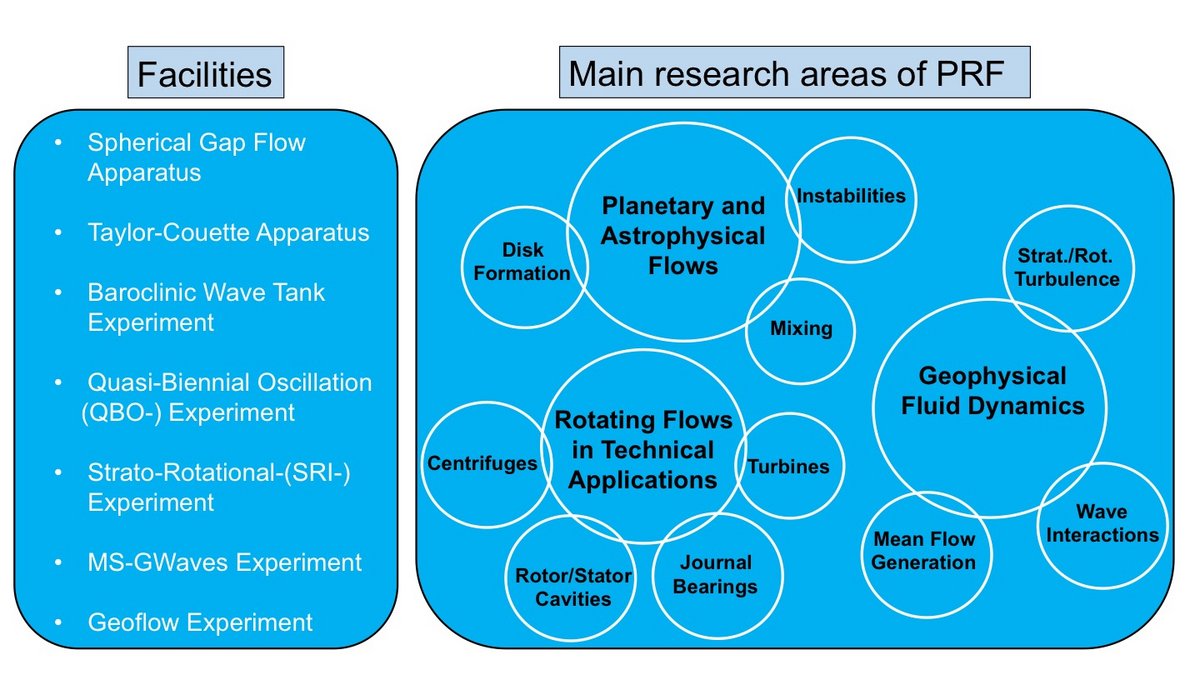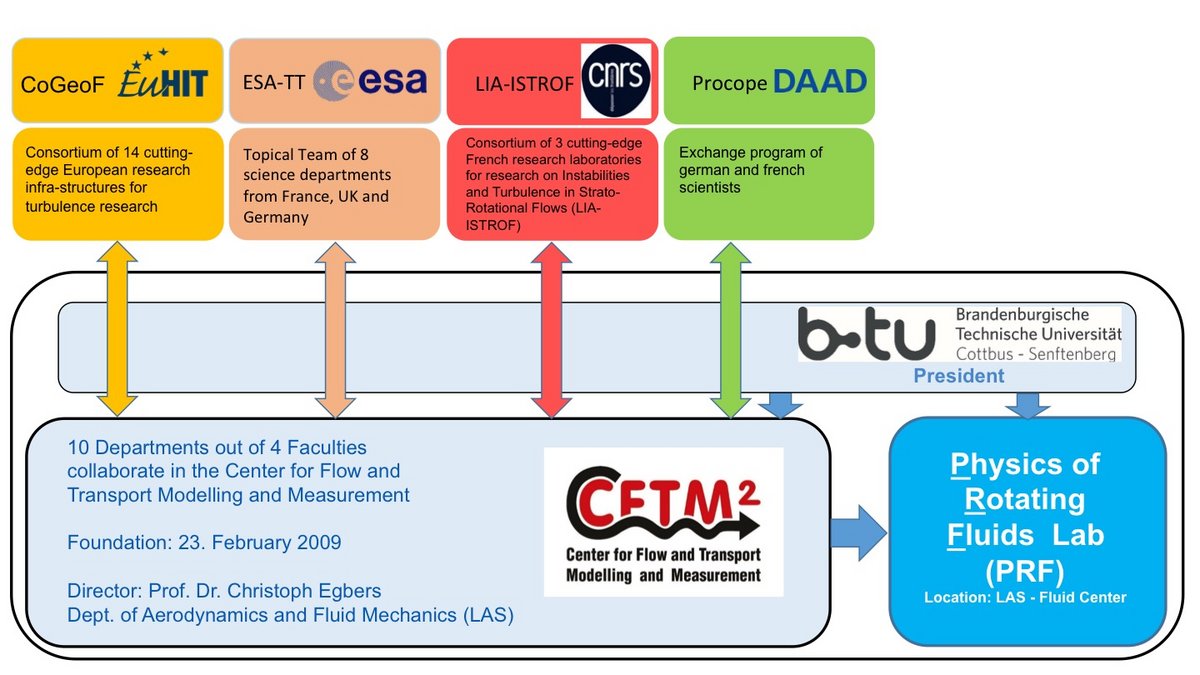Fluid Mechanics
DFG Core Facility Center "Physics of Rotating Fluids Lab" (EG 100/23-1; HA 2932/9-1)
The present proposal aims to establish a new international research center in form of a core facility center for "Physics of Rotating Fluids (PRF)" with geo-/astrophysical, meteorological and technical applications located at BTU. The main goal is to integrate cutting-edge rotating and stratified fluid flow experiments across national boundaries in order to foster internationally competitive experimental research in the research field of rotating and stratified fluids by providing an easy access to outstanding experimental facilities (Figure1, left) equipped with state-of-the-art instrumentation. The research areas covered by the experimental facilities inside the new center are (Figure 1, right):
- Planetary and astrophysical flows (with focus on disk formation, instabilities and mixing)
- Geophysical fluid dynamics (with focus on strato-rotational turbulence, mean flow generation and wave interaction)
- Rotating flows with technical applications (centrifuges, turbines, journal bearings and rotor/stator cavities)
Thus, the main goals of this proposal are to:
- advertise and enforce the different research activities on rotating and stratified fluid flow experiments at BTU
- provide these outstanding research facilities at BTU to a larger national and international research community
- bring together the recognized expertise of national and international working groups in the field of rotating and stratified fluids at BTU
- interconnect and help interested users by a networking program and joint research activities
- establish training groups for young researchers (Ph.D. students, Postdocs) in the field of rotating and stratified fluids
- organize exchange of scientific staff between the different research groups
- develop new experiments and models for a better insight into the dynamics and the role of these mean flows in geophysical, astrophysical, meteorological and technical flows at BTU
- deliver experimental data (including the use of modern experimental techniques like Thermography, Laser-Doppler-Anemometry, Particle Image Velocimetry (PIV), Laser Induced Fluorescence (LIF) techniques and Liquid Chrystal Tracer techniques, while the research approach as a whole is experimental, numerical and theoretical for the "PRF"
- organize and prepare collaborative applications to national and international calls for proposals (ANR, DFG, EU_FP8).
- collaborative data analysis of experimental, theoretical and numerical simulations.
These goals will be achieved by
- maintaining a suitable and safe physical environment with access to the required research services
- establishing a transparent and short review process for the external user community
- providing easy application forms for external scientific users, that ensures that proposals fit into the scientific frame of PRF research topics and are also compatible with the experiment facilities available
- sustaining a critical mass of scientific and technical expertise
- training and advising researchers as required
- providing appropriate and timely assistance
- enabling, advising and training on safe working practices
- ongoing research on new developments in instrumentation and responding to changes of experimental research; e.g. by designing, implementing or procuring appropriate mechanical, optical and electronic solutions to meet new experimental and diagnostic requirements
- documentation (user guides, safety-/laboratory manuals, annual reports, publications)
- public relations/ outreach (web-site, flyer, poster, presentations etc.)
- training / education (summer schools, workshops, young researcher meetings)
- continuation of core facility center activities after 3 years DFG funding through succeeding funding by BTU
Organization and interfaces of the core facility center “Physics of Rotating Fluids (PRF)”:
The new core facility center for “Physics of Rotating Fluids (PRF)” will cover and focus all previous single research and guest scientist exchange activities like EuHIT, CNRS French/German-co-operation and ESA Topical Team with BTU/CFTM² in the field of rotating and stratified fluid flows as illustrated in Fig. 2. After funding from DFG via the present proposal, the core facility center for “Physics of Rotating Fluids (PRF) will be continued and financed sustainably by BTU.
Services and joint research activities of the core facility center "Physics of Rotating Fluids (PRF)":
The actual status of the core facility center for "Physics of Rotating Fluids (PRF)" comprises all experimental facilities and measurement techniques located in the Fluid-Center-Building in different rooms next to each other.
The PRF will be located in the Fluid-Center-building. Responsible for the experiments is the Department of Aerodynamics and Fluid Mechanics. In this department about 20 technical & scientific employees work on experimental, theoretical and numerical questions of fluid mechanics. Generally we offer two types of services: i) in situ research with a direct access to the facility, and ii) commissioned research. In the first case i), the user in person will be conducting the research at our facility. To these researchers we offer practical guidance as well as technical assistance on the part of our scientific and/or technical staff, which is necessary due to the high complexity of the experimental installations. In preparation of such joint research project, the user will work with the facility lead scientist and the facility technician. The guesthouse of the BTU will minimize the organizational effort required for arranging the visits to the different facilities. In the second case ii), the commissioned research, the user can demand for certain measurements to be performed at our facility without being actually present in Cottbus. In this case our personnel will carry out the requested measurements and transmit the results to the user. This type of research is particularly appealing to users from the computational fluid dynamics community who are interested in validating their numerical data using experimental data.
Scientific experimental equipment:
- Spherical gap flow apparatus (DFG EG 100/1-1, 1-2)
- Taylor-Couette apparatus (DFG EG 100/2, EG 100/7; EG 100/15-1, 15-2; FOR1182)
- Baroclinic wave tank experiment (DFG EG 100/3; EG 100/13-1, 13-2, 13-3; SPP 1276 "Metström")
- Quasi-Biennial Oscillation (QBO-) experiment (DFG EG 100/14-1; HA2932/6-1)
- Strato-Rotational-experiment (DFG EG 100/18-1; HA2932/7-1)
- MS-GWaves experiment (HA2932/8-1; FOR 1898)
- Geoflow experiments (DLR, ESA)
Measurement equipment
- 2D-Particle Image Velocimetry (PIV) System, 15mJ Nd:YAG LASER, monochromatic CCD camera, resolution 1 megapixel (New Wave Research, TSI)
- Stereo-PIV system, 100mJ Nd:YAG LASER, 2 cameras with 2 MP resolution (Dantec Dynamics)
- Dantec Dyn. Laser Induced Fluorescence (LIF) system to measure concentration and temperature
- Volumetric Velocimetry, 100mJ Nd:YAG LASER, 3 cameras with a resolution of 2 megapixel, telecentric lenses for a measurement volume of 10 x 10 x 10 cm3 (Dantec Dynamics)
- Particle Tracking (2D, 3D) with the dantec system mentioned above
- 2x 1D (He-Ne LASER) and 2D Laser Doppler Anemometry (LDA), Ar-Ion-LASER
- Infrared-Thermography system
Bibliography:
- Egbers, Ch., Pfister, G., (Eds), 2000, Physics of Rotating Fluids, Lecture Notes in Physics 549, Springer
- Harlander, U., v. Larcher, T., Wang, Y., Egbers, Ch., 2011, PIV- and LDV-measurements of baroclinic wave interactions in a thermally driven rotating annulus, Exp. Fluids, 51, 37-49, DOI 10.1007/s00348-009-0792-5
- Feudel, F., Bergemann, K. , Tuckerman, L., Egbers, Ch., Futterer, B., Gellert, M., Hollerbach, R., 2011, Convection patterns in a spherical fluid shell, Phys. Rev. E, 83 (2011), 046304
- Harlander, U., Wenzel, J., Alexandrov, K., Wang, Y., Egbers, C., 2012, Simultaneous PIV- and thermography-measurements of partially blocked flow in a heated rotating annulus, Exp. Fluids, 52, 1077-1085
- Koch, S., Harlander, U., Egbers, Ch., Hollerbach, R., 2013, Inertial waves in a spherical shell induced by librations of the inner sphere: experimental and numerical results, Fluid Dyn. Res. 45, Best paper 2013 Jap. Soc. Fluid Mech.
- Merbold, S., Brauckmann, H.J., Egbers, Ch., 2013, Torque measurements and numerical determination in differentially rotating wide gap Taylor-Couette flow, Phys. Rev. E 87, 023014
- Futterer, B., Krebs, A., Plesa, A.-C., Zaussinger, F., Hollerbach, R., Breuer, D., Egbers, Ch., 2013, Sheet-like and plume-like thermal flow in a spherical convection experiment performed under microgravity, J. Fluid Mech., vol. 735, 647-683 , Cambridge University Press 2013, doi:10.1017/jfm.2013.507,
- Klein, M., Seelig, T., Kurgansky, M. V., Ghasemi V., A., Borcia, I.-D., Will, A., Schaller, E., Egbers, Ch., Harlander, U., 2014, Inertial wave excitation and focusing in a liquid bounded by a frustum and a cylinder, J. Fluid Mech., vol. 751, 255-297, doi:10.1017/jfm.2014.304, 2014
- Vincze, M., Borchert, S., Achatz, U., von Larcher, Th., Baumann, M., Liersch, C., Remmler, S., Beck, T., Alexandrov, K.D., Egbers, Ch., Fröhlich, J., Heuveline, V., Hickel, S., Harlander, U., 2014, Benchmarking in a rotating annulus: a comparative experimental and numerical study of baroclinic wave dynamics, Meteorolog. Zeitschrift, 23, 611 - 635
- Harlander, U., v. Larcher, Th., Wright, G.B., Hoff, M., Egbers, Ch., 2014, Orthogonal decomposition methods to analyze PIV, LDV and thermography data of a thermally driven rotating annulus laboratory experiment. AGU book: Modelling Atmospheric and Oceanic flows: insights from laboratory experiments and numerical simulations, Th. v. Larcher and P. Williams (ed.), Wiley


